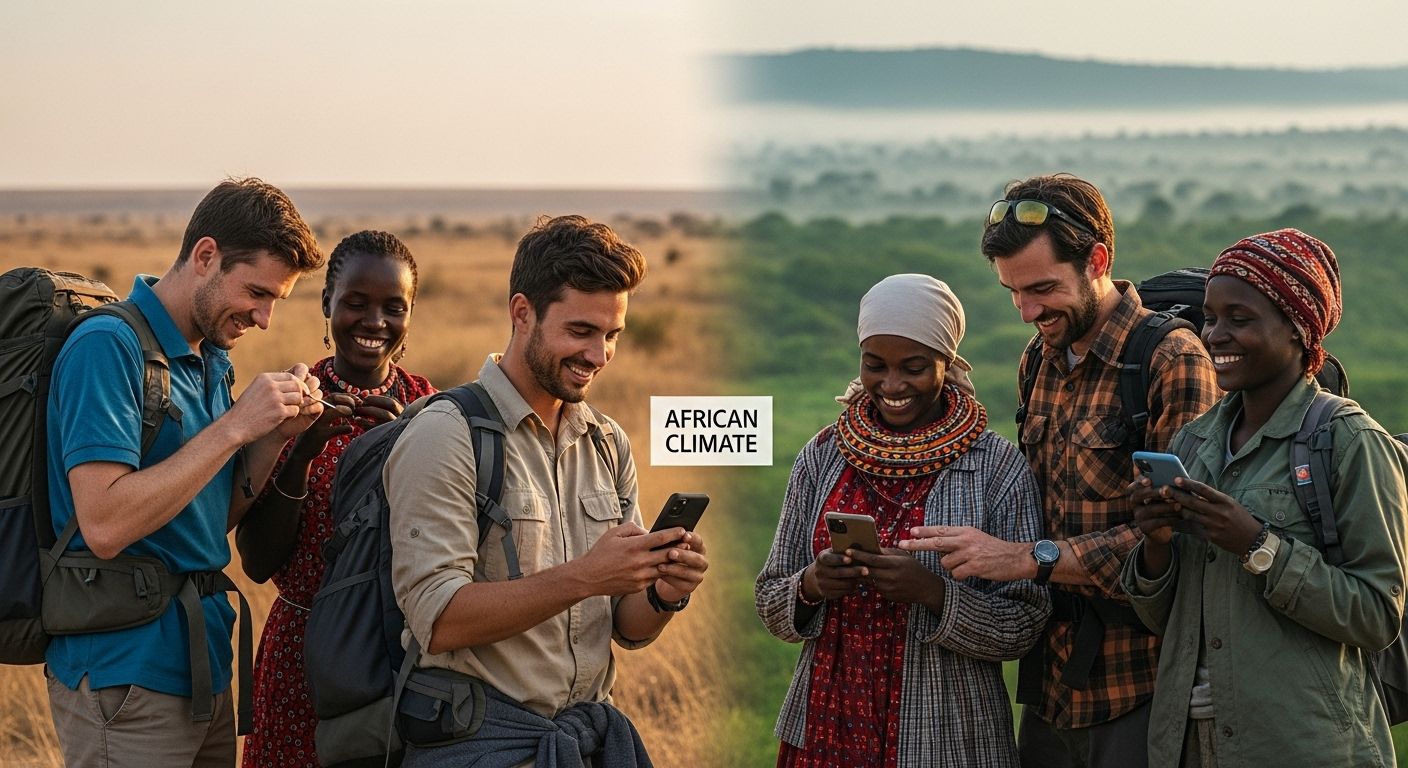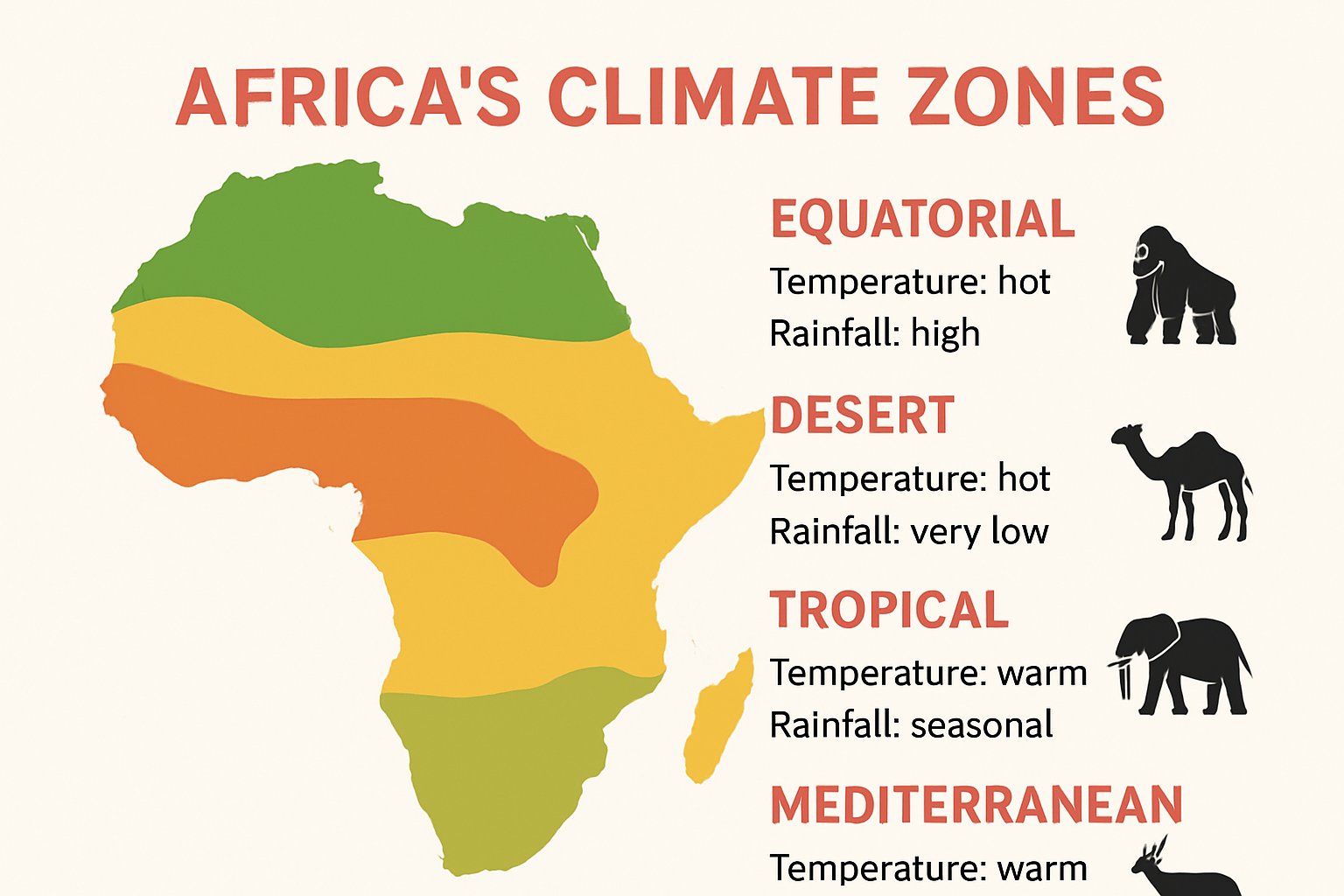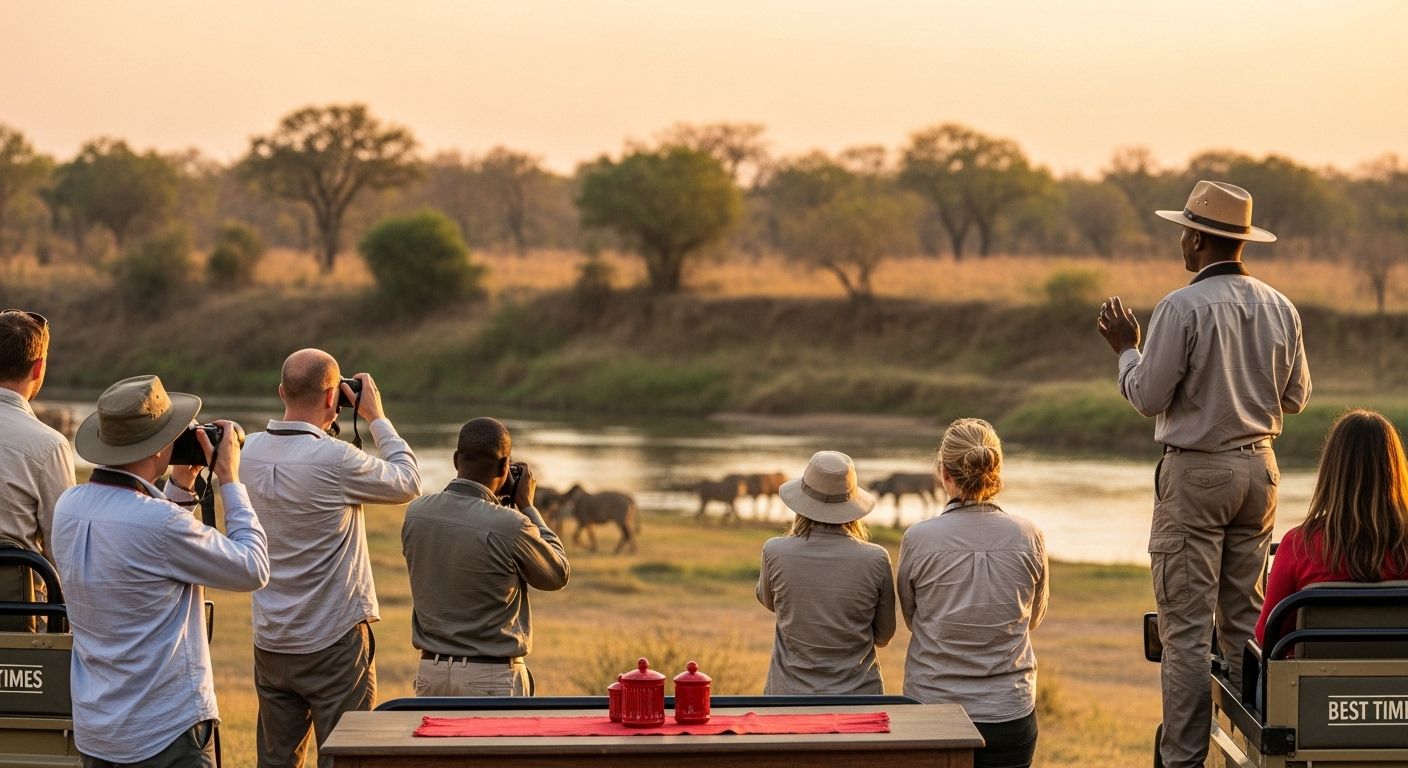African Climate and Weather: What Travellers Need to Know
Full Disclosure: Our AI Assistant Writes These!
While we're out in the bush tracking leopards, dodging elephants, and trying to get the perfect sunset shot, our trusty AI companion is back at camp, diligently crafting these blog posts. Don't worry though - it's been trained on years of real safari experiences and only occasionally suggests that tourists should pet the lions. (Please don't pet the lions. The AI was joking. We hope.)
The real reason? SEO loves fresh content, and we love fresh adventures. So while our AI handles the keywords and search rankings, we're out there finding the next hidden waterhole, secret viewpoint, or that one tree where the leopards always hang out. Win-win, really!
African Climate and Weather: What Travellers Need to Know

Africa’s climate can go from icy mountain mornings to blistering desert afternoons within just a few hundred kilometres. Some places like the Sahara can reach daytime temperatures above 50 degrees Celsius and then drop close to freezing at night. Most travellers expect endless sunshine but the biggest surprise is how much the weather can actually shape your whole African adventure if you do not plan well.
Table of Contents
- Understanding African Climate Zones
- Seasonal Weather Patterns Across Africa
- Best Times For Safaris And Adventures
- Tips For Travellers: Weather And Packing
Quick Summary
| Takeaway | Explanation |
|---|---|
| Understand regional climate zones | Africa features diverse climate zones that affect travel plans and wildlife experiences. Knowing them is key for successful trips. |
| Plan for extreme weather variations | Temperatures can vary dramatically, especially between day and night. Proper clothing and flexibility are essential for comfort. |
| Travel in the dry season for wildlife viewing | The dry season, from June to October, offers the best opportunities for observing wildlife congregating around limited water sources. |
| Layer clothes for climate adaptability | Pack lightweight layers for easy temperature adjustments across different African regions. This ensures comfort throughout your trip. |
| Research specific regional conditions | Each region has unique weather patterns and seasonal highlights. Understanding these ensures better travel planning and experiences. |
Understanding African Climate Zones
Africa’s vast and diverse landscape creates a complex tapestry of climate zones that challenge and fascinate travelers. Understanding these varied climatic regions is crucial for planning a successful journey across the continent. From scorching deserts to lush tropical rainforests, Africa presents an extraordinary range of environmental conditions that can dramatically impact travel experiences.

Latitude and Climate Diversity
Africa’s climate is fundamentally shaped by its geographical position straddling the equator. According to Encyclopaedia Britannica, the continent’s climate zones are primarily determined by latitude, which creates distinct temperature and precipitation patterns. Near the equator, travelers encounter consistently warm temperatures with minimal seasonal variation. As you move north or south, the climate transitions through tropical, subtropical, and temperate zones, each presenting unique environmental characteristics.
The equatorial regions, spanning countries near the central part of the continent, experience high humidity and substantial rainfall throughout the year. These areas support dense tropical forests and support incredibly rich biodiversity. In contrast, the northern and southern regions feature more pronounced seasonal changes, with distinct dry and wet periods that significantly influence wildlife movements and travel opportunities.
Regional Climate Variations
Research from Climates to Travel highlights the remarkable diversity of African climate zones. The continent can be broadly categorized into several distinct climatic regions:
To help readers quickly compare Africa’s main climate zones and their travel implications, the following table summarises key features and traveller considerations of each zone described above:
| Climate Zone | Key Characteristics | Travel Implications |
|---|---|---|
| Desert | Extreme temperatures, minimal precipitation; hot days, cold nights | Pack layered clothing, sun protection, prepare for rapid temperature changes |
| Tropical | Warm temperatures, high humidity, predictable heavy rainfall | Lightweight, breathable clothing, insect repellent, waterproof gear |
| Mediterranean | Mild, wet winters; hot, dry summers | Versatile attire; sun protection for summer, warmer clothes for winter |
| Equatorial | Consistently warm, very humid, two rainy seasons | Waterproof, moisture-wicking clothing, robust insect protection |
| Semi-Arid | Large daily temperature swings, very low rainfall | Layers for temperature variation, sun protection |
-
Desert Zones: Characterized by extreme temperatures and minimal precipitation, regions like the Sahara in the north and the Kalahari in the south present challenging environmental conditions. Daytime temperatures can soar above 50 degrees Celsius, while nighttime temperatures can plummet dramatically.
-
Tropical Zones: These regions near the equator maintain consistently warm temperatures with high humidity. Rainfall patterns here are typically more predictable, supporting lush vegetation and complex ecosystems.
-
Mediterranean Zones: Predominantly found in North Africa, these areas experience mild, wet winters and hot, dry summers. Countries like Morocco and Tunisia showcase this distinctive climate pattern.
Seasonal Considerations for Travelers
Understanding these climate zones is more than an academic exercise for travelers. Each zone presents unique challenges and opportunities. The seasonal variations can dramatically impact wildlife movements, accessibility of certain regions, and overall travel comfort. For instance, the dry season in many wildlife reserves provides optimal game viewing opportunities, while the wet season transforms landscapes into vibrant, green environments.
Travelers should recognize that Africa’s climate is not uniform. A journey from the coastal regions to inland areas can involve significant temperature and precipitation changes. Proper preparation, including appropriate clothing, understanding local weather patterns, and flexible travel planning, becomes essential.
For more detailed insights into planning your safari adventure around seasonal variations, read our comprehensive guide on safari timing.
Seasonal Weather Patterns Across Africa
Seasonal weather patterns in Africa represent a complex and dynamic system that significantly impacts travel, wildlife movements, and local ecosystems. Understanding these patterns is crucial for travelers seeking to maximize their African adventure and navigate the continent’s diverse climatic conditions.
The Influence of the Inter-Tropical Convergence Zone
Research published in the National Center for Biotechnology Information reveals that Africa’s seasonal weather is primarily driven by the movement of the Inter-Tropical Convergence Zone (ITCZ). This meteorological phenomenon plays a critical role in determining rainfall patterns across different regions. The ITCZ follows the sun’s position, creating distinct wet and dry seasons that vary dramatically depending on geographical location.
In equatorial regions, this results in a bi-modal rainfall pattern, with two distinct rainy seasons. As you move away from the equator, the rainy season becomes shorter and less predictable. The length of the rainy season directly impacts local ecosystems, agricultural cycles, and ultimately, travel experiences across the continent.
Regional Seasonal Variations
According to Encyclopaedia Britannica, Africa’s seasonal patterns can be broadly categorized into several distinctive zones:
-
Equatorial Regions: Characterized by consistent high temperatures and two distinct rainy periods. These areas maintain relatively stable conditions throughout the year, with humidity levels typically high and temperatures remaining warm.
-
Tropical Zones: Experience more pronounced wet and dry seasons. The dry season often coincides with peak wildlife viewing opportunities, making it ideal for safari adventures. Learn more about optimal safari timing.
-
Desert and Semi-Arid Regions: These areas display minimal seasonal variation in overall temperature but experience significant daily temperature fluctuations. Rainfall is extremely limited, with some regions experiencing years without substantial precipitation.
Practical Implications for Travelers
Understanding seasonal weather patterns is more than an academic exercise for travelers. Each season brings unique challenges and opportunities. The dry season typically offers better wildlife viewing conditions, with animals congregating around limited water sources. Conversely, the wet season transforms landscapes into lush, green environments, creating stunning photographic opportunities and supporting vibrant ecosystems.
Travellers should consider how seasonal weather affects different African regions and the type of experiences they can expect. This table summarises the main seasonal patterns and practical implications for each region:
| Region | Seasonal Pattern | Best Time to Visit | Travel Highlights |
|---|---|---|---|
| Equatorial | Two rainy seasons, little temp change | Year-round | Lush forests, high humidity, rich wildlife |
| Tropical | Distinct wet/dry seasons | Dry season (Jun-Oct) | Peak wildlife viewing, open landscapes |
| Desert/Semi-Arid | Hot days, cold nights, rare rain | Cooler months (May-Sep) | Dramatic scenery, stargazing, low crowds |
| Mediterranean (N. Africa) | Wet winters, dry-hot summers | Spring/Autumn | Moderate temperatures, cultural experiences |
| Southern Africa | Cool winters, dry—wet summers | Winter (May-Sep) | Wildlife congregate at waterholes, safaris |
Travelers must consider several factors when planning their African journey. Temperature variations can be extreme, with desert regions experiencing daytime temperatures soaring above 40 degrees Celsius and dropping dramatically at night. Coastal and highland regions offer more moderate temperatures, providing welcome relief from the intense heat.
Rainfall patterns also significantly impact travel logistics. Some regions become virtually impassable during peak rainy seasons, with muddy roads and potential flooding. Others offer spectacular natural displays, such as the annual wildebeest migration, which is intricately linked to seasonal weather patterns.
Prudent travelers will research specific regional conditions, pack appropriate clothing, and maintain flexible itineraries. Explore our comprehensive guide to African migration patterns to understand how seasonal changes influence wildlife movements and travel experiences.
Best Times for Safaris and Adventures
Planning the perfect African safari requires strategic timing and an understanding of the continent’s diverse seasonal dynamics. The right moment can transform a good trip into an extraordinary adventure, offering unparalleled wildlife encounters and breathtaking natural experiences.
Peak Safari Seasons
Safari Bookings research indicates that the dry season, typically spanning June to October, represents the optimal period for wildlife viewing across most African parks and reserves. During these months, animals congregate around diminishing water sources, creating exceptional opportunities for observation and photography.
The dry season presents unique advantages for travelers. Sparse vegetation makes wildlife spotting significantly easier, and animals become more predictable in their movements. Predators are more visible as they hunt near water sources, while herbivores gather in impressive herds, creating spectacular viewing experiences. Understand the intricacies of safari planning to maximize your adventure potential.
Regional Variations and Unique Experiences
According to Audley Travel, Africa’s seasonality creates extraordinary natural phenomena. While the dry season remains popular, the period immediately following the wet season offers equally compelling experiences. During this time, landscapes transform into verdant wonderlands, woodlands teem with birdlife, and fewer tourists mean more intimate wildlife encounters.
Different regions offer unique seasonal highlights:
- East Africa: July and August mark the peak of the Great Wildebeest Migration, an unparalleled natural spectacle.
- Southern Africa: Winter months (May to September) provide optimal wildlife viewing conditions with clear skies and minimal vegetation.
- West African Regions: Seasonal variations are less pronounced, offering more consistent wildlife viewing opportunities.
Strategic Travel Planning
Discover Africa experts emphasize that July represents the pinnacle of safari experiences. This month offers exceptional conditions across multiple destinations, from gorilla trekking in Rwanda to wildlife observations in various national parks.
Travelers should consider more than just wildlife viewing when planning their adventure. Factors like temperature, rainfall, accessibility, and specific wildlife events play crucial roles in determining the ideal travel time. Some experiences, such as the wildebeest migration or specific bird migrations, occur during narrow windows and require precise timing.
Beyond wildlife, consider complementary experiences like coastal adventures in Mozambique or exploring different ecological zones. Each region presents unique seasonal characteristics that can dramatically enhance your travel experience.
Remember that flexibility is key. While guidelines provide excellent starting points, Africa’s natural world is dynamic and unpredictable. Local conditions can vary yearly, so consulting with experienced safari operators and maintaining an open mindset will ensure an unforgettable journey.
For travelers seeking a comprehensive understanding of safari experiences, explore our definitive safari guide to prepare for your African adventure.

Tips for Travellers: Weather and Packing
Successful African travel hinges on intelligent preparation and strategic packing. Understanding the continent’s diverse climatic conditions and preparing accordingly can transform a potentially challenging journey into an extraordinary adventure.
Layering and Climate Adaptability
Packing for Africa requires a nuanced approach that accommodates dramatic temperature variations and diverse environmental conditions. According to Africa Geographic, travelers must prepare for significant temperature fluctuations, especially in regions transitioning between desert, coastal, and highland environments.
The key strategy is layering. Lightweight, breathable base layers combined with versatile mid-layers and a waterproof outer layer provide maximum flexibility. Neutral-toned clothing in fabrics like moisture-wicking synthetics and light cotton offer both practical protection and respect for local cultural sensitivities. Explore our comprehensive safari packing guide to ensure you’re fully prepared.
Essential Gear and Protection
Beyond clothing, travelers must consider specialized gear that protects against Africa’s challenging environmental conditions. Key items include:
-
Sun Protection: High-SPF sunscreen, wide-brimmed hats, and UV-protective clothing are non-negotiable. Equatorial and desert regions expose travelers to intense solar radiation.
-
Insect Defense: Lightweight, long-sleeved shirts and pants, coupled with high-quality insect repellent, provide crucial protection against mosquitoes and other insects that can carry tropical diseases.
-
Hydration and Health: Portable water purification systems, electrolyte supplements, and a comprehensive first-aid kit tailored to your specific destinations are essential.
Regional Packing Considerations
Strategic packing is essential for African travel. The table below highlights the recommended clothing and gear for various climate regions based on the packing advice provided in this section:
| Region/Environment | Clothing & Gear Recommendations | Key Reason |
|---|---|---|
| Desert | Layered, breathable clothes, sun hat, sunglasses, high-SPF sunscreen | Extreme heat by day, cold by night |
| Tropical/Equatorial | Lightweight, moisture-wicking clothes, insect repellent, rain jacket | High humidity, frequent rain, insect exposure |
| Safari | Neutral, earth-toned attire, sturdy boots, hat, binoculars | Wildlife viewing, blending into environment |
| Mountain/Highland | Warm thermal layers, waterproof jacket, hiking boots | Cold mornings/evenings, variable weather |
| Coastal | Quick-dry clothes, strong sun protection, sandals | Hot sun, humidity, water activities |
Each African region demands unique preparation. Coastal areas require lightweight, quick-drying clothing and robust sun protection. Safari destinations necessitate practical, earth-toned attire that blends with natural environments. Mountain regions demand warm layers and waterproof gear.
Electronic devices require careful consideration. Bring universal adapters, portable chargers, and consider the durability of your equipment against dust, humidity, and temperature extremes. Protective cases and silica gel packets can help preserve sensitive electronics.
Footwear is another critical consideration. Comfortable, broken-in hiking boots for safari and walking adventures, plus lightweight, breathable shoes for urban environments, provide versatile coverage. Water-resistant options offer additional protection during unexpected rain.
Medical preparedness extends beyond a standard first-aid kit. Consult your healthcare provider about recommended vaccinations, carry prescription medications in original packaging, and consider travel insurance that covers medical evacuation.
Remember that packing light does not mean compromising on preparedness. Strategic selection of multipurpose items, understanding local laundry facilities, and choosing quick-drying, wrinkle-resistant fabrics can significantly reduce luggage weight.
Check out our detailed safari clothing recommendations to refine your packing strategy and ensure you’re fully equipped for an unforgettable African adventure.
Frequently Asked Questions
What are the main climate zones in Africa?
Africa features diverse climate zones including desert, tropical, Mediterranean, equatorial, and semi-arid regions. Each zone has distinct temperature and rainfall patterns that affect travel plans and wildlife experiences.
When is the best time to go on safari in Africa?
The best time for safari in Africa is typically during the dry season from June to October, when wildlife congregates around limited water sources, making it easier for observation and photography.
How should I prepare for extreme temperature variations in Africa?
To prepare for extreme temperature variations, pack layered clothing that can adapt to changes in climate, including lightweight base layers, versatile mid-layers, and a waterproof outer layer to accommodate both hot days and cold nights.
What essential gear should I bring for travel in African climates?
Essential gear for travel in African climates includes sun protection (high-SPF sunscreen, wide-brimmed hats), insect repellent for protection against mosquitoes, portable water purification systems, and a comprehensive first-aid kit tailored to your specific destinations.
Turn Your Weather Knowledge Into an Unforgettable African Adventure
Planning a trip to Africa can feel overwhelming when climate zones, unpredictable temperatures and seasonal challenges stand in your way. You have just read how the right timing and careful packing make all the difference for comfort and wildlife encounters. But no amount of research compares to personalised advice and professionally crafted tours made for the continent’s ever-changing weather.

Why not let Africa Awesome’s experts take this burden off your shoulders? With our tailored safari packages and up-to-date destination insight, you get trips that match your ideal season, weather preferences and adventure style. Get real-time guidance on when to visit for migration, the best safari weather, or a sun-soaked beach escape. Start your journey today at Africa Awesome or use our guide to the best time for African safari to plan your trip with zero guesswork. Your extraordinary African expedition is just one click away.